Research into the Eutrophication of an Artificial Playground Lake near the Yangtze River
Abstract
:1. Introduction
2. Study Area and Methods
2.1. Study Area
2.2. Study Methods
2.2.1. Two-Dimensional Hydrodynamic Model
2.2.2. Two-Dimensional Water Quality and Eutrophication Model
2.3. Model Setup and Parameter Selection
2.3.1. Model Setup
2.3.2. Parameter Selection
2.4. Calculation Programs
2.4.1. Water Diversion through Sluice
2.4.2. Water Diversion through Pump
3. Results and Discussion
3.1. Particle Tracking
3.2. Flow Field Calculation and Analysis
3.2.1. Calculation and Analysis of Flow Field with No Water Diversion
3.2.2. Calculation and Analysis of Flow Field with Water Diversion through Pump
3.2.3. Calculation and Analysis of Flow Field with Water Diversion through Sluice
3.3. Water Quality and Eutrophication
3.3.1. Calculation and Analysis of the Water Quality and Eutrophication with No Water Diversion
3.3.2. Calculation and Analysis of Water Quality and Eutrophication with Water Diversion through Pump
3.3.3. Calculation and Analysis of Water Quality and Eutrophication with Water Diversion through Sluice
4. Water Ecological Protection Measures
5. Conclusions
- (1)
- Simulation results using particle tracking showed that the water residence time depended on wind direction: east wind, 125 h; southeast wind, 115 h; south wind, 95 h. Particles did not pass the Moya area under all three wind directions. Particles in central landscape lake experienced a backflow phenomenon and the water residence time was longer. However, eventually the water still flowed out to achieve water replacement. With no water diversion, the flow velocity in Playground Lake under the three wind fields was low, and the shallow depth of shore water was greatly affected by wind speed.
- (2)
- The Chl-a, TN, TP concentrations and eutrophication comprehensive score under the three wind directions were 0.014 mg/L, 1.49 mg/L, 0.11 mg/L and 58.0, respectively. In conformity with the flow field, the water retention caused the Chl-a, TN, and TP contents to be higher. Under pump diversion, the water replacement result of water diversion for 30 h was better than that of water diversion for 22 h. Following water diversion for 22 h, the eutrophication comprehensive score was 51.4, showing mild eutrophication. Following water diversion for 30 h, the eutrophication comprehensive score was 47.7 points, so the water quality improvement effect was more obvious. Under sluice diversion, the flow field scope of the Moya area was the largest in Playground Lake, followed by the Shuijie area. The flow velocity in central landscape lake was low, and in some areas it was lower than 0.01 m/s. The improvement of water quality with sluice diversion was very rapid and obvious. The water quality was consistent with the regulation of the flow field. The greater the Δh, the higher the flow velocity. The better the water quality, the lower the eutrophication evaluation score. The central landscape lake and three sections of Shuijie had relatively poor water quality leading to eutrophication. Overall, the good-to-bad order of water quality improvements for Playground Lake is as follows: pumping 30 h > sluice diversion > no water diversion.
- (3)
- According to the model calculations, the following ecological operation was planned: During high tide periods of spring tides in the Yangtze River from June to August, the water can be diverted into the lake through sluices. At other time, the water is pumped by the #1 pump. Under pump diversion, the water body in Playground Lake can be replaced by water diversion for 30 h. When the temperature is less than 15 °C, from 15 °C to 25 °C and higher than 25 °C, the water quality can be maintained for 15 d, 10 d and 7 d, respectively. These water quality improvement measures can effectively control the occurrence of eutrophication.
Acknowledgments
Author Contributions
Conflicts of Interest
References
- Marshall, H.G.; Burchardt, L. Phytoplankton composition within the tidal freshwater region of the James River, Virginia. Proc. Biol. Soc. Wash. 1998, 111, 720–730. [Google Scholar]
- Ha, K.; Cho, E.A.; Kim, H.W.; Joo, G.J. Microsystis bloom formation in the lower Nakong River, South Korea. Importance of hydro-dynamics and nutrient loading. Mar. Freshw. Res. 1999, 50, 89–94. [Google Scholar] [CrossRef]
- Lung, W.S.; Paerl, H.W. Modeling blue-green algal blooms in the lower Neuse River. Water Res. 1988, 22, 895–905. [Google Scholar] [CrossRef]
- Steinberg, C.; Hartmann, H. Planktonic bloom forming cyanobacteria and the eutrophication of lakes and rivers. Freshw. Biol. 1988, 20, 279–287. [Google Scholar] [CrossRef]
- Eldridge, M.; Sieracki, M.E. Biological and hydrodynamic regulation of the microbial food web in a periodically mixed estuary. Limnol. Oceanogr. 1993, 38, 1666–1679. [Google Scholar] [CrossRef]
- Qin, B. Approaches to Mechanisms and Control of Eutrophication of Shallow Lakes in the Middle and Lower Reaches of the Yangze River. J. Lake Sci. 2002, 14, 193–202. [Google Scholar] [CrossRef]
- Qin, B.; Wang, X.; Tang, X.; Feng, S.; Zhang, Y. Drinking Water Crisis Caused by Eutrophication and Cyanobacterial Bloom in Lake Taihu: Cause and Measurement. Adv. Earth Sci. 2007, 22, 896–906. [Google Scholar]
- Zhu, G. Eutrophic status and causing factors for a large, shallow and subtropical Lake Taihu, China. J. Lake Sci. 2008, 20, 21–26. [Google Scholar] [CrossRef]
- Liang, P.; Wang, X.; Ma, F. Effect of hydrodynamic conditions on water eutrophication: A review. J. Lake Sci. 2013, 25, 455–462. [Google Scholar] [CrossRef]
- Zhao, Y.; Deng, X.; Zhan, J.; Xi, B.; Lu, Q. Progress on Preventing and Controlling Strategies of Lake Eutrophication in China. Environ. Sci. Technol. 2010, 33, 92–98. [Google Scholar]
- Qu, W.; Yan, L. Effects of Agricultural Non-point Source Pollution on Eutrophica tion of Water Body and Its Control Measure. Acta Ecol. Sin. 2002, 22, 291–299. [Google Scholar]
- Pu, P.; Wang, G.; Hu, C.; Hu, W.; Fan, C. Can We Control Lake Eutrophication by Dredging? J. Lake Sci. 2000, 12, 269–279. [Google Scholar] [CrossRef]
- Song, W.; Pang, Y. The Calculation of Water Environment Capacity of Qinhuai River Basin Based on the National Test of QB-CS Water Quality Standards. China Rural Water Hydropower 2017, 10, 80–84. [Google Scholar] [CrossRef]
- Conley, D.J.; Paerl, H.W.; Howarth, R.W.; Boesch, D.F.; Seitzinger, S.P.; Havens, K.E.; Lancelot, C.; Likens, G.E. Ecology. Controlling eutrophication: Nitrogen and phosphorus. Science 2009, 323, 1014. [Google Scholar] [CrossRef] [PubMed]
- Cloern, J.E. Our evolving conceptual model of the coastal eutrophication problem. Mar. Ecol. Prog. 2001, 210, 223–253. [Google Scholar] [CrossRef]
- Smith, V.H. Eutrophication of freshwater and coastal marine ecosystems a global problem. Environ. Sci. Pollut. Res. Int. 2003, 10, 126–139. [Google Scholar] [CrossRef] [PubMed]
- Shapiro, J. Blue-green algae: Why they become dominant. Science 1973, 179, 382–384. [Google Scholar] [CrossRef] [PubMed]
- Dokulil, M.T.; Teubner, K. Cyanobacterial Dominance in Eutrophic Lakes: Causes-Consequences-Solutions. J. Lake Sci. 1998, 10, 357–370. [Google Scholar] [CrossRef]
- Dokulil, M.; Chen, W.; Cai, Q. Anthropogenic impacts to large lakes in China: The Tai Hu example. Aqu. Ecosyst. Health Manag. 2000, 3, 81–94. [Google Scholar] [CrossRef]
- Paerl, H.W.; Rd, F.R.; Moisander, P.H.; Dyble, J. Harmful freshwater algal blooms, with an emphasis on cyanobacteria. Sci. World J. 2001, 1, 76–113. [Google Scholar] [CrossRef] [PubMed]
- Smith, V.H. Low Nitrogen to Phosphorus Ratios Favor Dominance by Blue-Green Algae in Lake Phytoplankton. Science 1983, 221, 669–671. [Google Scholar] [CrossRef] [PubMed]
- Wang, H.; Pang, Y. Investigation of internal pollutant loading for a tide-influenced waterbody. Water Environ. Res. 2009, 81, 2437–2446. [Google Scholar] [CrossRef]
- Wang, H.; Zhou, Y.; Pang, Y.; Wang, X. Fluctuation of Cadmium Load on a Tide-Influenced Waterfront Lake in the Middle-Lower Reaches of the Yangtze River. Clean Soil Air Water 2015, 42, 1402–1408. [Google Scholar] [CrossRef]
- Wang, H.; Zhou, Y.; Pang, Y.; Wang, X. Influence of dredging on sedimentary arsenic release for a tide-influenced waterfront body. J. Environ. Qual. 2014, 43, 1585–1592. [Google Scholar] [CrossRef] [PubMed]
- Wang, H.; Xia, K.; Zhou, Y.; Mu, W. Impact of Water-Sediment Exchange on Underwater Terrain Shaping Process for a Tide-Influenced Waterfront Lake. J. Hydrol. Eng. 2014, 20, 04014093. [Google Scholar] [CrossRef]
- Li, Y.; Wang, Y.; Anim, D.O.; Tang, C.; Du, W.; Ni, L.; Yu, Z.; Acharya, K. Flow characteristics in different densities of submerged flexible vegetation from an open-channel flume study of artificial plants. Geomorphology 2014, 204, 314–324. [Google Scholar] [CrossRef]
- Li, Y.; Tang, C.; Wang, C.; Tian, W.; Pan, B.; Hua, L.; Lau, J.; Yu, Z.; Acharya, K. Assessing and modeling impacts of different inter-basin water transfer routes on Lake Taihu and the Yangtze River, China. Ecol. Eng. 2013, 60, 399–413. [Google Scholar] [CrossRef]
- Li, Y.; Tang, C.; Wang, C.; Anim, D.O.; Yu, Z.; Acharya, K. Improved Yangtze River Diversions: Are they helping to solve algal bloom problems in Lake Taihu, China? Ecol. Eng. 2013, 51, 104–116. [Google Scholar] [CrossRef]
- Zhao, X.; Shen Z, Y.; Xiong, M.; Qi, J. Key uncertainty sources analysis of water quality model using the first order error method. Int. J. Environ. Sci. Technol. 2011, 8, 137–148. [Google Scholar] [CrossRef]
- Piermay, J.L. Long-term simulation of the eutrophication of the North Sea: Temporal development of nutrients, chlorophyll and primary production in comparison to observations. J. Sea Res. 1997, 38, 275–310. [Google Scholar]
- Nobre, A.M.; Ferreira, J.G.; Newton, A.; Simas, T.; Icely, J.D.; Neves, R. Management of coastal eutrophication: Integration of field data, ecosystem-scale simulations and screening models. J. Mar. Syst. 2005, 56, 375–390. [Google Scholar] [CrossRef]
- Sagehashi, M.; Sakoda, A.; Suzuki, M. A mathematical model of a shallow and Eutrophic Lake (The Keszthely Basin, Lake Balaton) and simulation of restorative manipulations. Water Res. 2001, 35, 1675–1686. [Google Scholar] [CrossRef]
- Madden, C.J.; Kemp, W.M. Ecosystem model of an estuarine submersed plant community: Calibration and simulation of eutrophication responses. Estuaries 1996, 19, 457–474. [Google Scholar] [CrossRef]
- Karim, M.R.; Sekine, M.; Ukita, M. Simulation of eutrophication and associated occurrence of hypoxic and anoxic condition in a coastal bay in Japan. Mar. Pollut. Bull. 2002, 45, 280–285. [Google Scholar] [CrossRef]
- Huang, Y.L.; Huang, G.H.; Liu, D.F.; Zhu, H.; Sun, W. Simulation-based inexact chance-constrained nonlinear programming for eutrophication management in the Xiangxi Bay of Three Gorges Reservoir. J. Environ. Manag. 2012, 108, 54–65. [Google Scholar] [CrossRef] [PubMed]
- Wang, H.; Zhang, Z.; Liang, D.; Du, H.; Pang, Y.; Hu, K.; Wang, J. Separation of wind's influence on harmful cyanobacterial blooms. Water Res. 2016, 98, 280–292. [Google Scholar] [CrossRef] [PubMed]
- Wang, H.; Zhao, Y.; Liang, D.; Deng, Y.; Pang, Y. 30+ year evolution of Cu in the surface sediment of Lake Poyang, China. Chemosphere 2017, 168, 1604–1612. [Google Scholar] [CrossRef] [PubMed]
- Wang, J.; Pang, Y.; Li, Y.; Huang, Y.; Jia, J.; Zhang, P.; Kou, X. The regularity of wind-induced sediment resuspension in Meiliang Bay of Lake Taihu. Water Sci. Technol. 2014, 70, 167–174. [Google Scholar] [CrossRef] [PubMed]
- Han, F.; Chen, Y.; Liu, Z. Advance in the eutrophication models for lakes and reservoirs. Adv. Water Sci. 2003, 14, 785–791. [Google Scholar]
- Lu, X.; Xu, F.; Zhan, W.; Zhao, Z.Y.; Tao, S. Current situation and development trends in lake eutrophication models. Adv. Water Sci. 2003, 14, 792–798. [Google Scholar]
- Quan, W.; Yan, L.; Yu, Z.; Jiao, L. Advance in study of lake eutrophication models. Chin. Biodivers. 2001, 9, 168–175. [Google Scholar]
- Cai, Y. Study on the Characteristics of Molecular Weight Distributions of Organic Matters in Zhenjiang City’s Drinking Water. Water Purif. Technol. 2005, 24, 12–16. [Google Scholar]
- Wang, G.S.; Shi, J.J.; Ling, L.U. Evaluation and Measures of Building Zhenjiang into an Eco-city. J. East China Shipbuild. Inst. 2005, 5, 54–59. [Google Scholar]
- Chen, S.; Qu, F.; Ni, S.; Liu, Y. City land price distribution researching in GIS spatial analysis—A case study of Zhenjiang City. J. Nanjing Agric. Univ. 2005, 28, 119–122. [Google Scholar] [CrossRef]
- Wan, Y.L.; Zhang, B. Analysis on the Pollution Characteristics of Surface Runoff in Zhenjiang City. Meteorol. Environ. Res. 2011, 5, 76–78. [Google Scholar]
- Ruan, H.; Ye, J.; Xu, X. Restoration of plant community in degradation riparian zone of Jinshan Lake in Zhenjiang city. J. Nanjing For. Univ. 2008, 32, 107–110. [Google Scholar]
- Chinese Std. GB3838-2002, Environment Quality Standards for Surface Water; SEPA of China: Beijing, China, 2002. [Google Scholar]
- Chinese Std. The Evaluation Method of Eutrophication and Classification of Lake (Reservoir); China Environment Monitoring Station: Beijing, China, 2001. [Google Scholar]
- Scavia, D.; Powers, W.F.; Canale, R.P.; Moody, J.L. Comparison of first-order error analysis and Monte Carlo Simulation in time-dependent lake eutrophication models. Water Resour. Res. 1981, 17, 1051–1059. [Google Scholar] [CrossRef]
- Geng, J.; Jin, X.; Wang, Q.; Niu, X.; Wang, X.; Edwards, M.; Glindemann, D. Matrix bound phosphine formation and depletion in eutrophic lake sediment fermentation-simulation of different environmental factors. Anaerobe 2005, 11, 273. [Google Scholar] [CrossRef] [PubMed]
- Okada, M.; Aiba, S. Simulation of water-bloom in a eutrophic lake—II. Reassessment of buoyancy, gas vacuole and Turgor pressure of Microcystis aeruginosa. Water Res. 1983, 17, 877–882. [Google Scholar] [CrossRef]
- Xu, M.J.; Yu, L.; Zhao, Y.W.; Li, M. The Simulation of Shallow Reservoir Eutrophication Based on MIKE21, A Case Study of Douhe Reservoir in North China. Procedia Environ. Sci. 2012, 13, 1975–1988. [Google Scholar] [CrossRef]
- Wang, X.Q.; Zhe, L.I. Swat and MIKE21 coupled models and three application in the Pengxi watershed. Resour. Environ. Yangtze Basin 2015, 24, 426–432. [Google Scholar]
- Qian, H.; Sheetz, M.P.; Elson, E.L. Single particle tracking. Analysis of diffusion and flow in two-dimensional systems. Biophys. J. 1991, 60, 910–921. [Google Scholar] [CrossRef]
- Malik, N.A.; Dracos, Th.; Papantoniou, D.A. Particle tracking velocimetry in three-dimensional flows. Exp. Fluids 1993, 15, 279–294. [Google Scholar] [CrossRef]
- Maas, H.G.; Gruen, A.; Papantoniou, D. Particle tracking velocimetry in three-dimensional flows Part 1. Photogrammetric determination of particle coordinates. Exp. Fluids 1993, 15, 133–146. [Google Scholar] [CrossRef]
- North, E.W.; Schlag, Z.; Hood, R.R.; Li, M.; Zhong, L.; Kennedy, V.S. Vertical swimming behavior influences the dispersal of simulated oyster larvae in a coupled particle-tracking and hydrodynamic model of Chesapeake Bay. Mar. Ecol. Prog. 2008, 359, 99–115. [Google Scholar] [CrossRef]
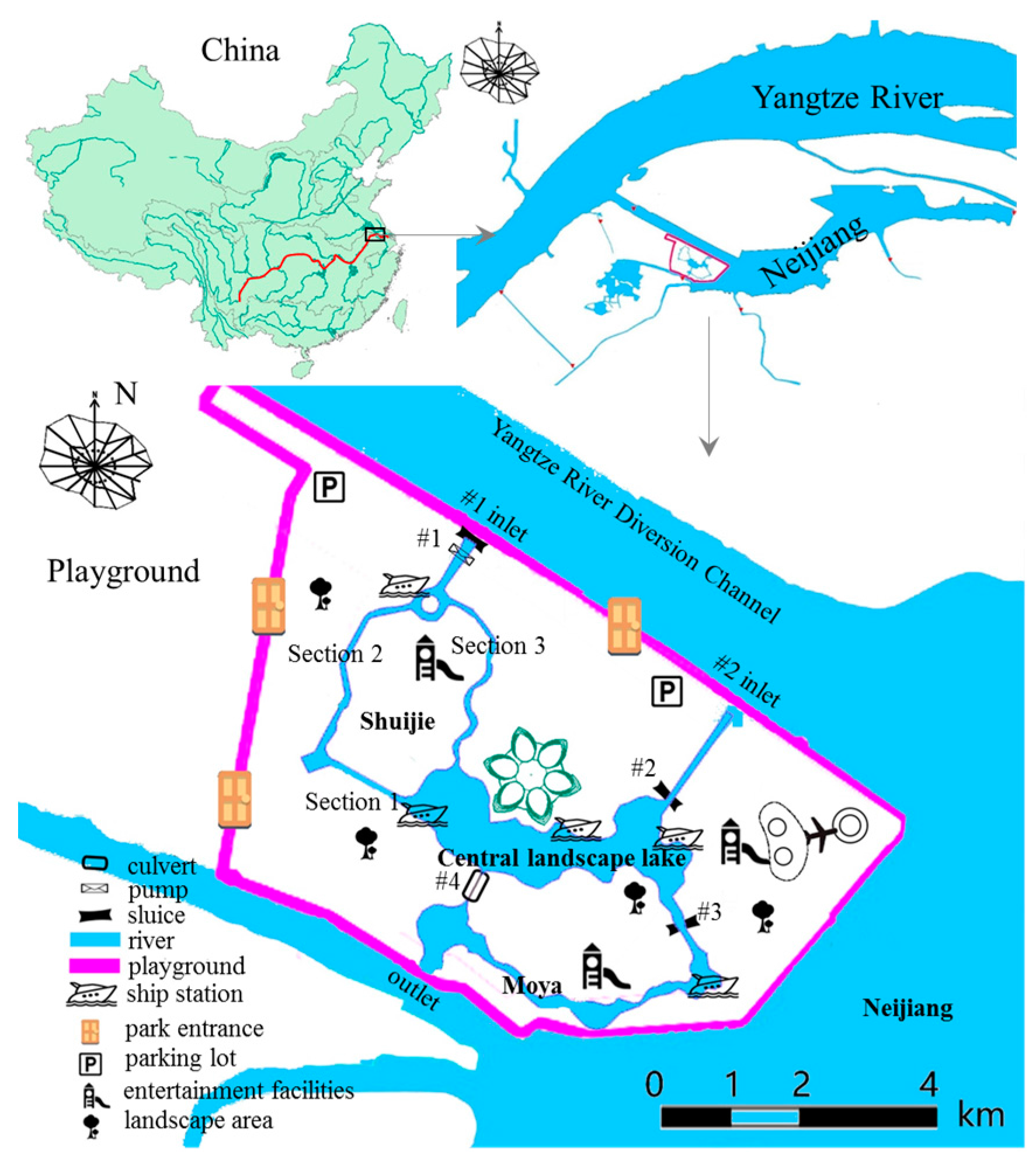

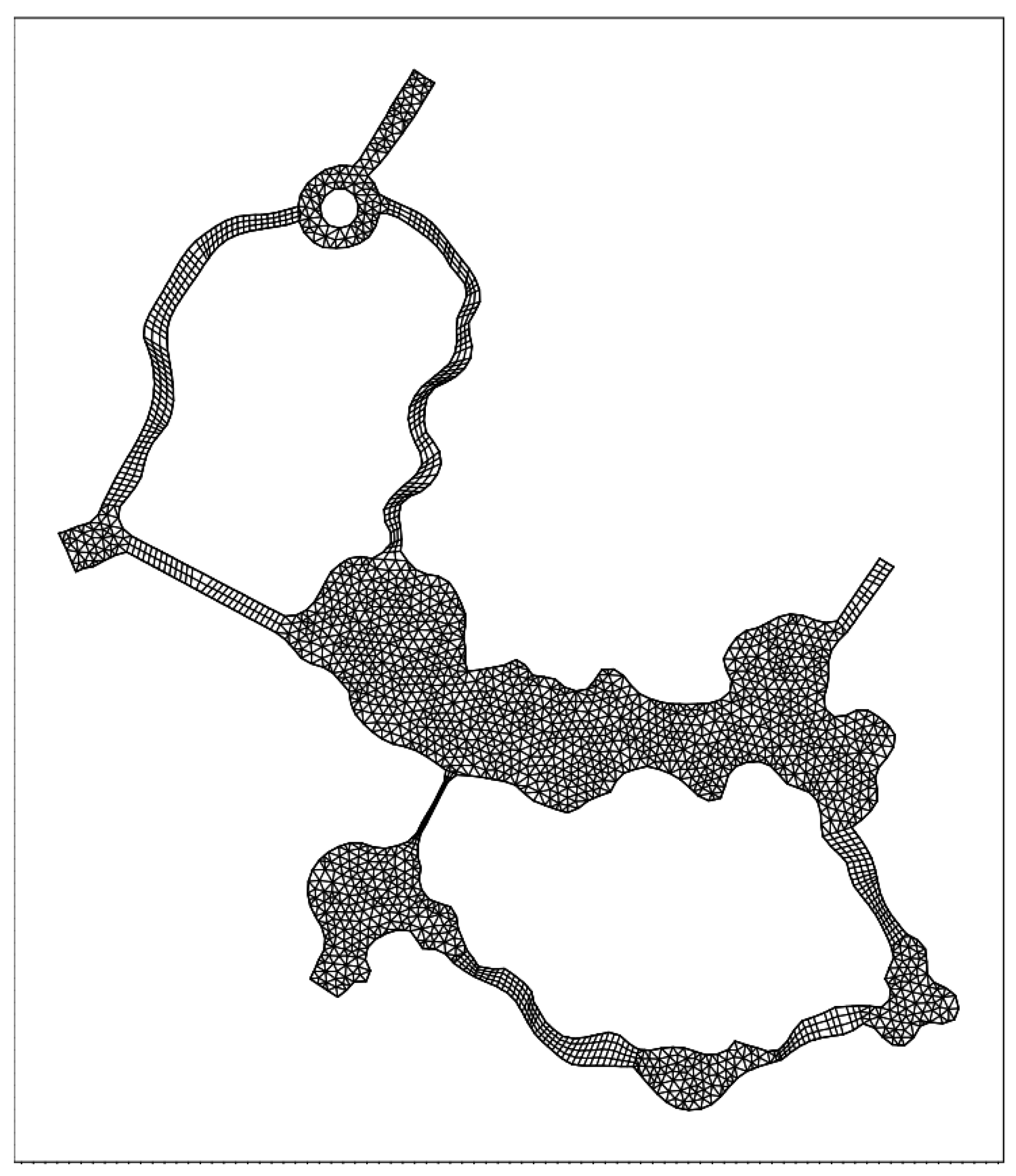
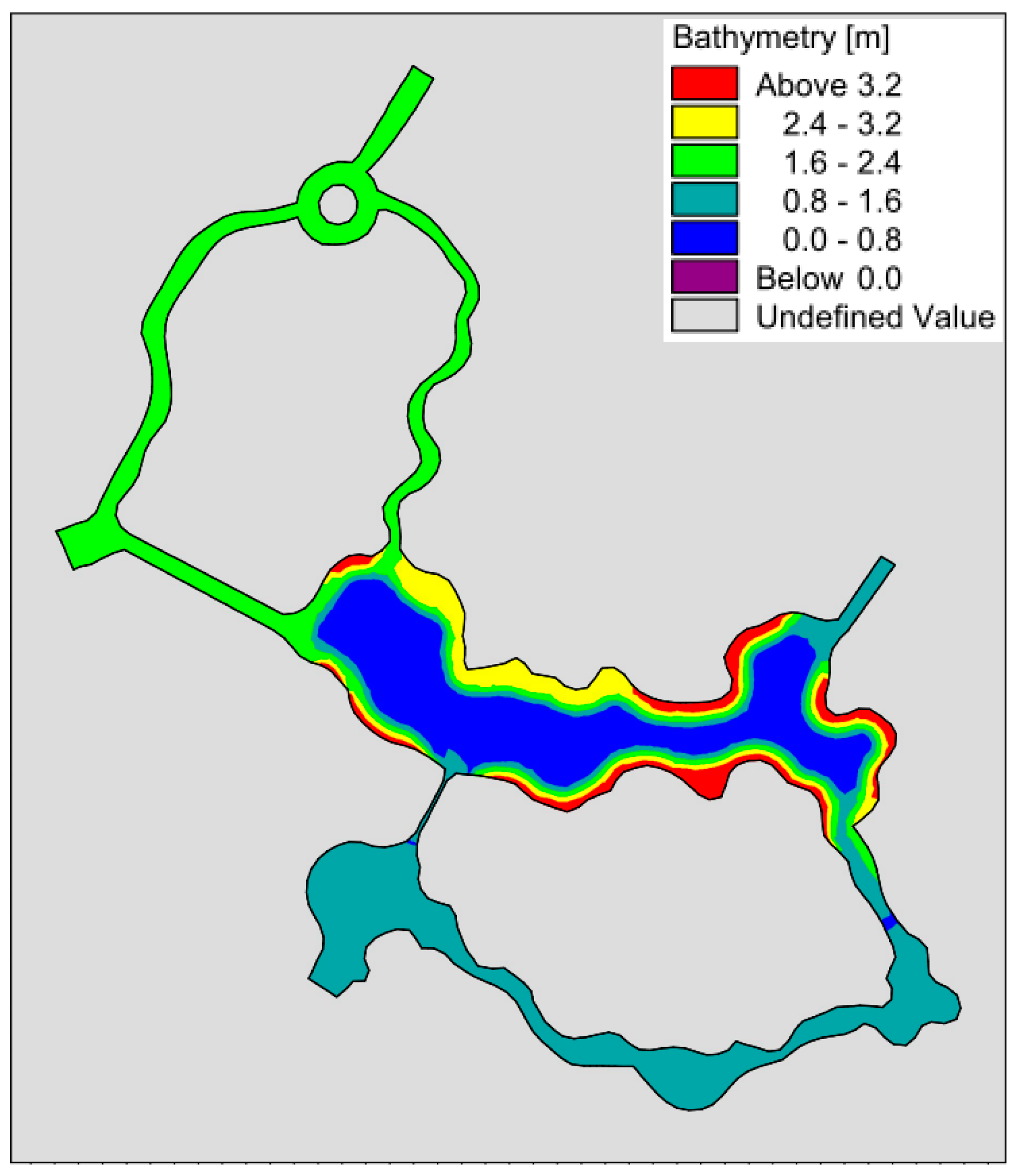
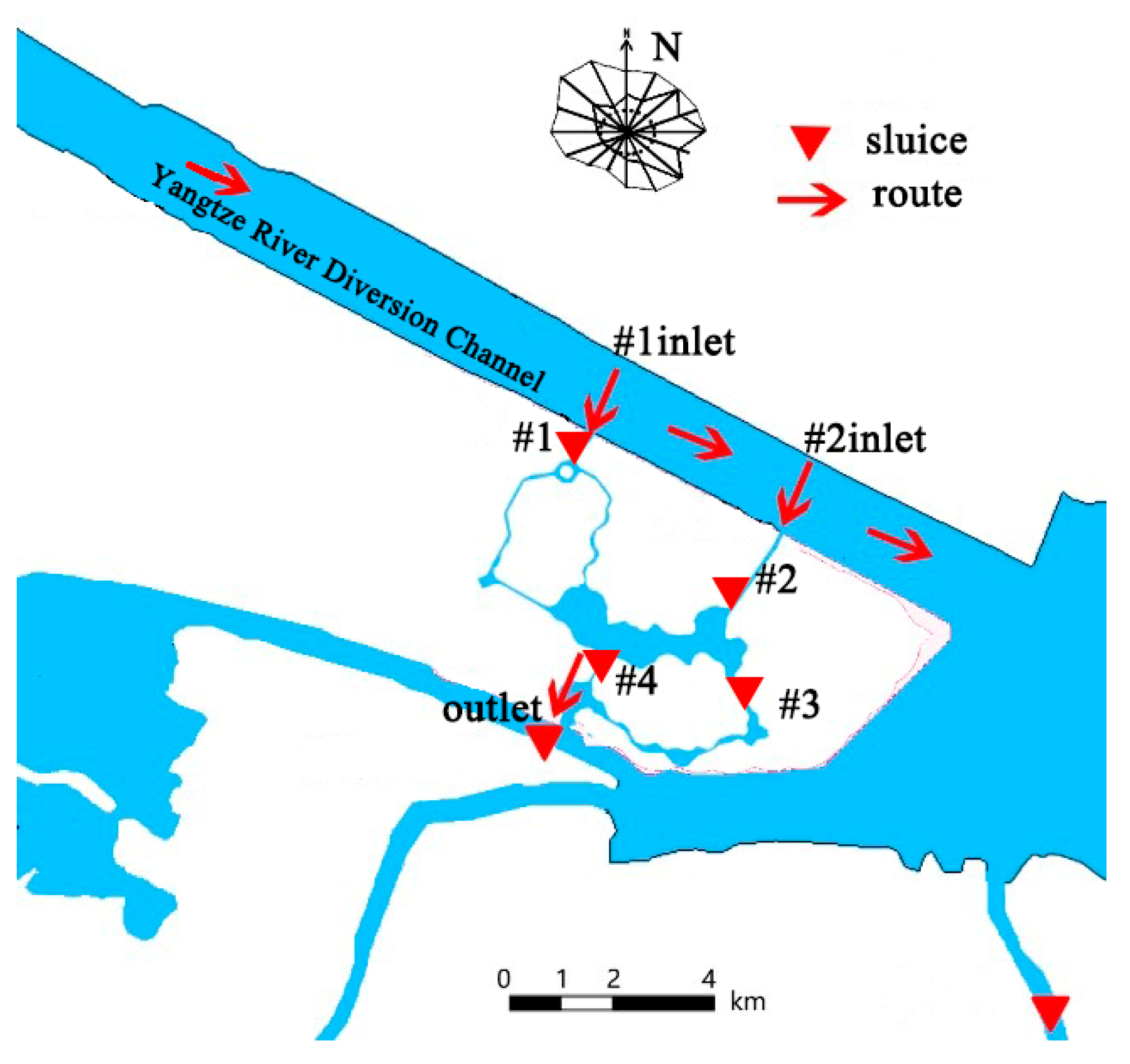
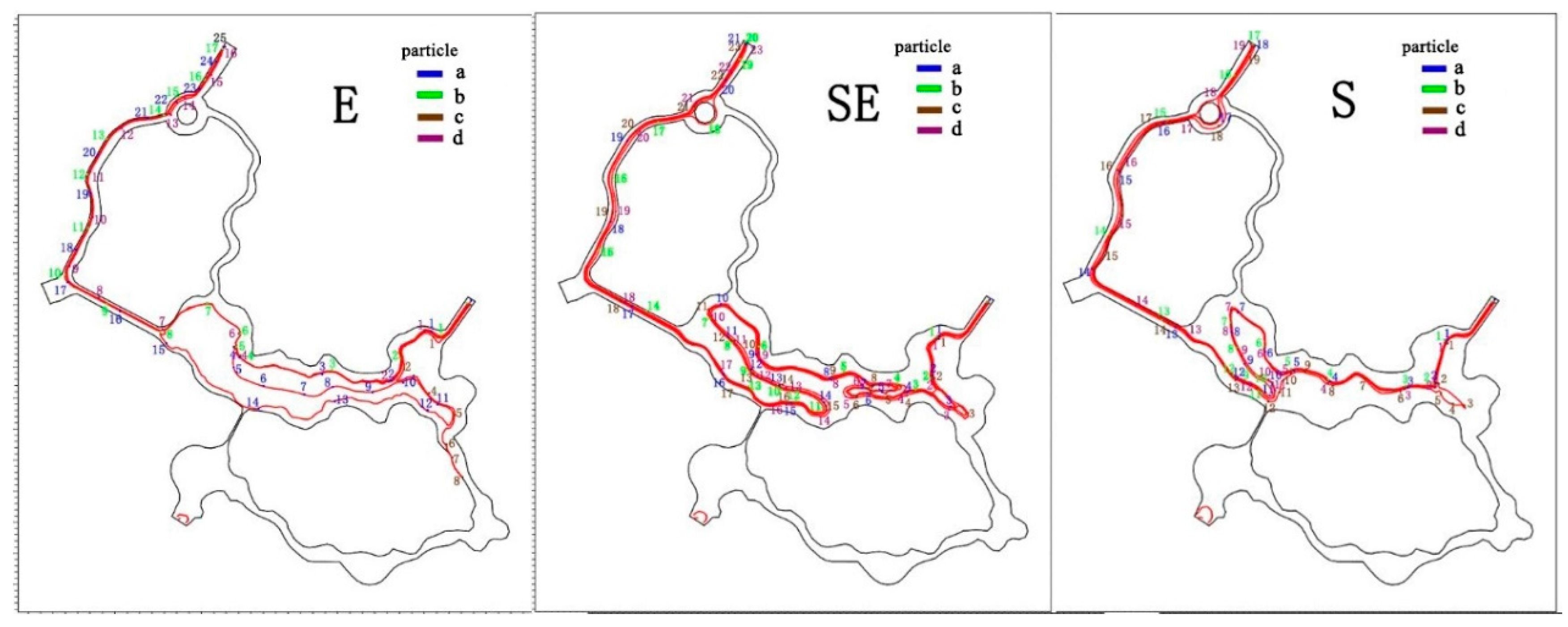
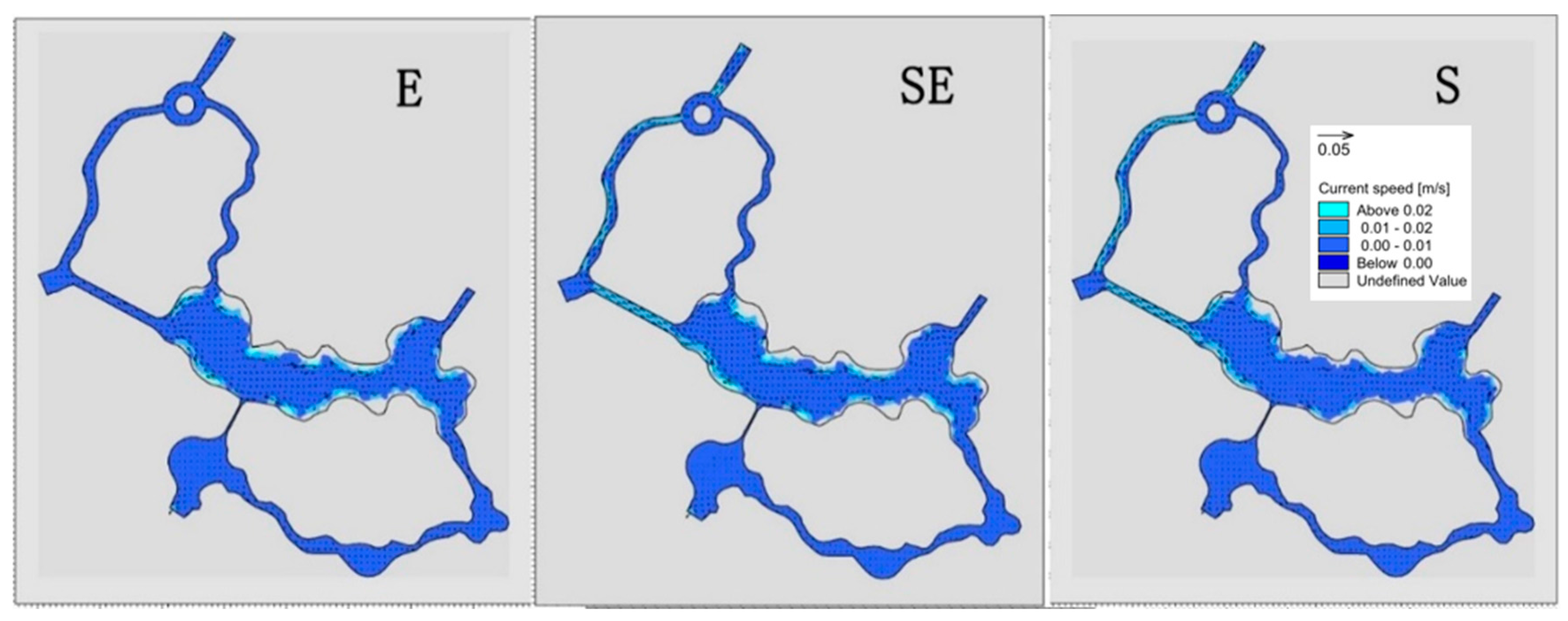
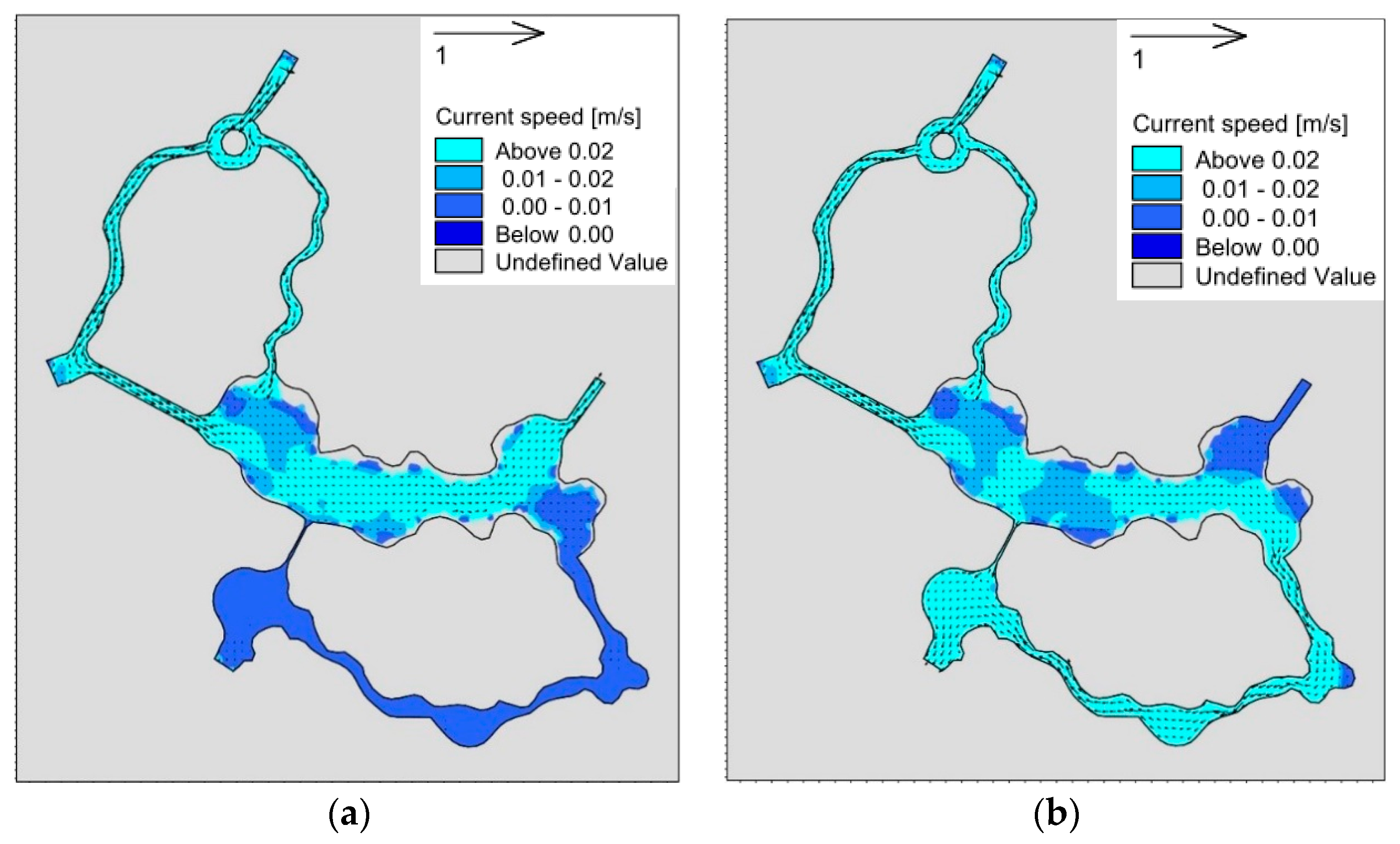
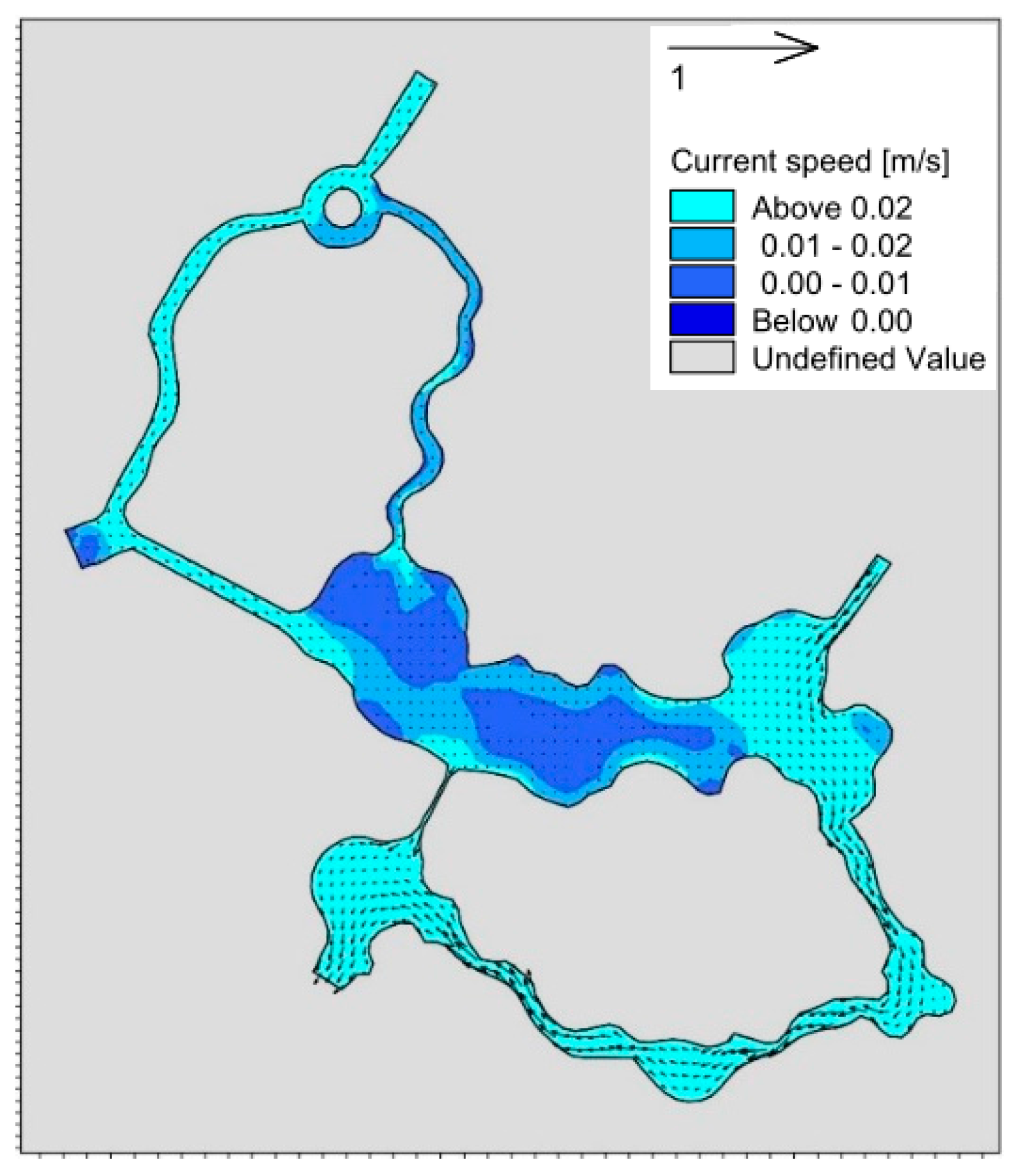
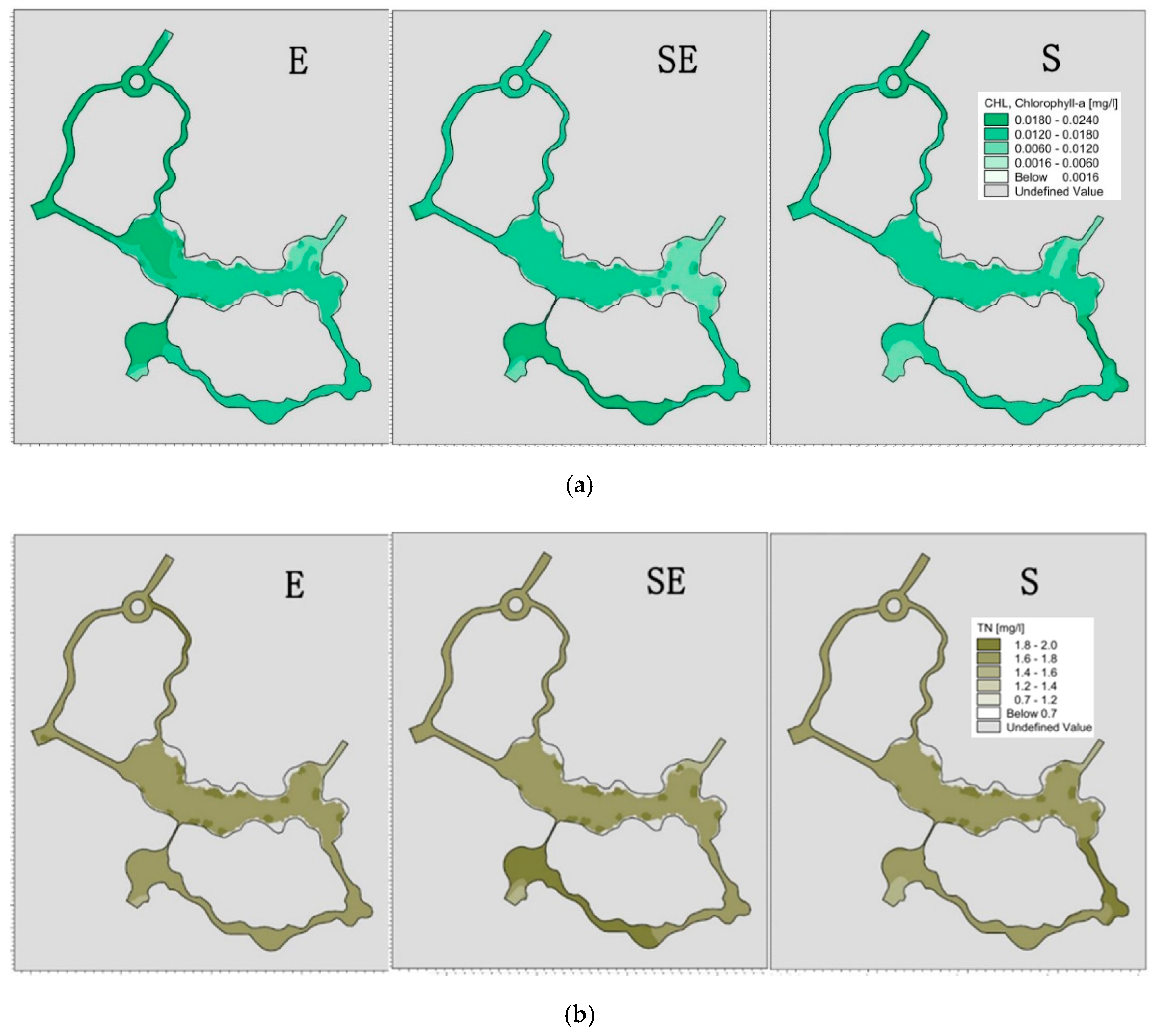
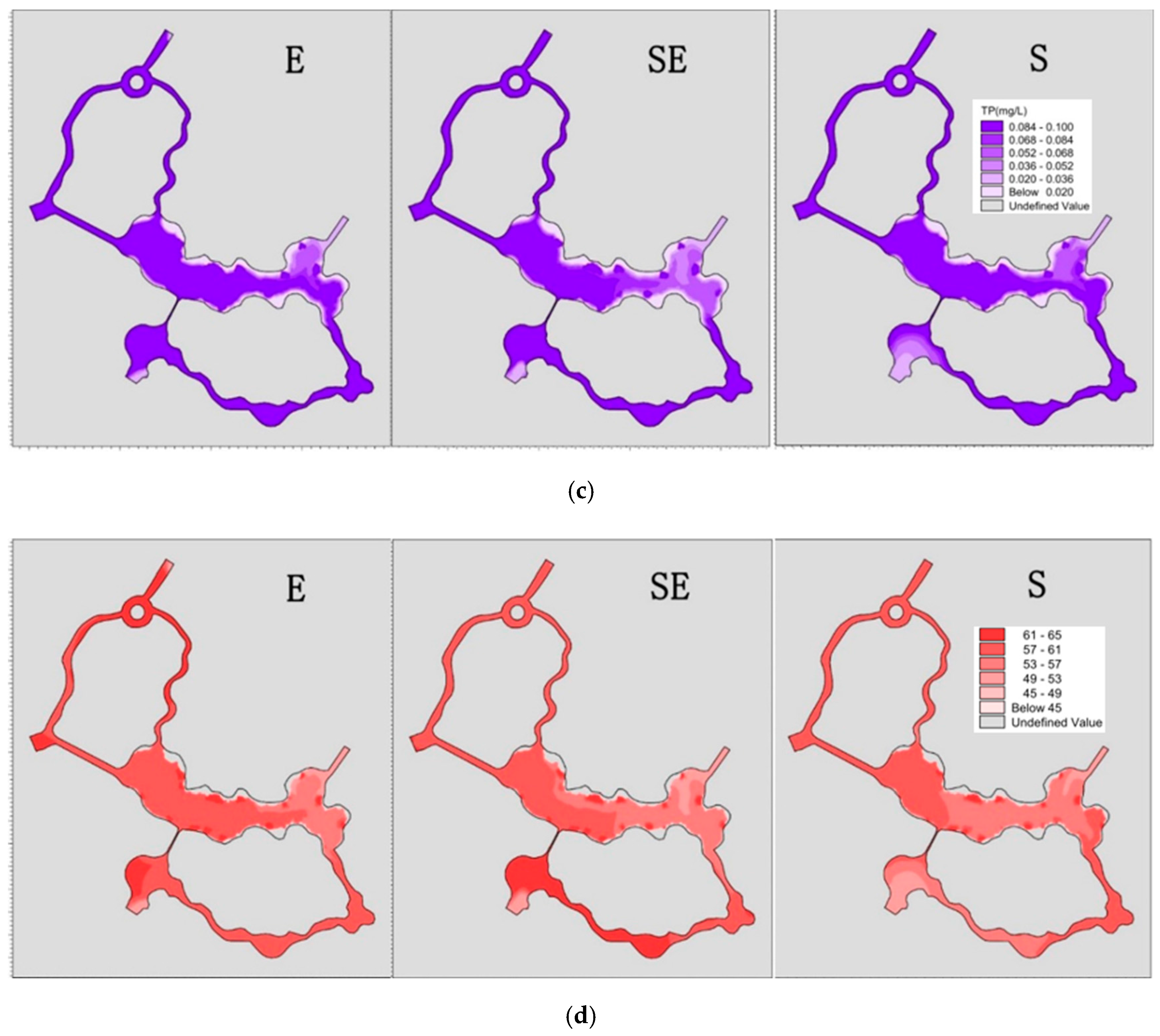
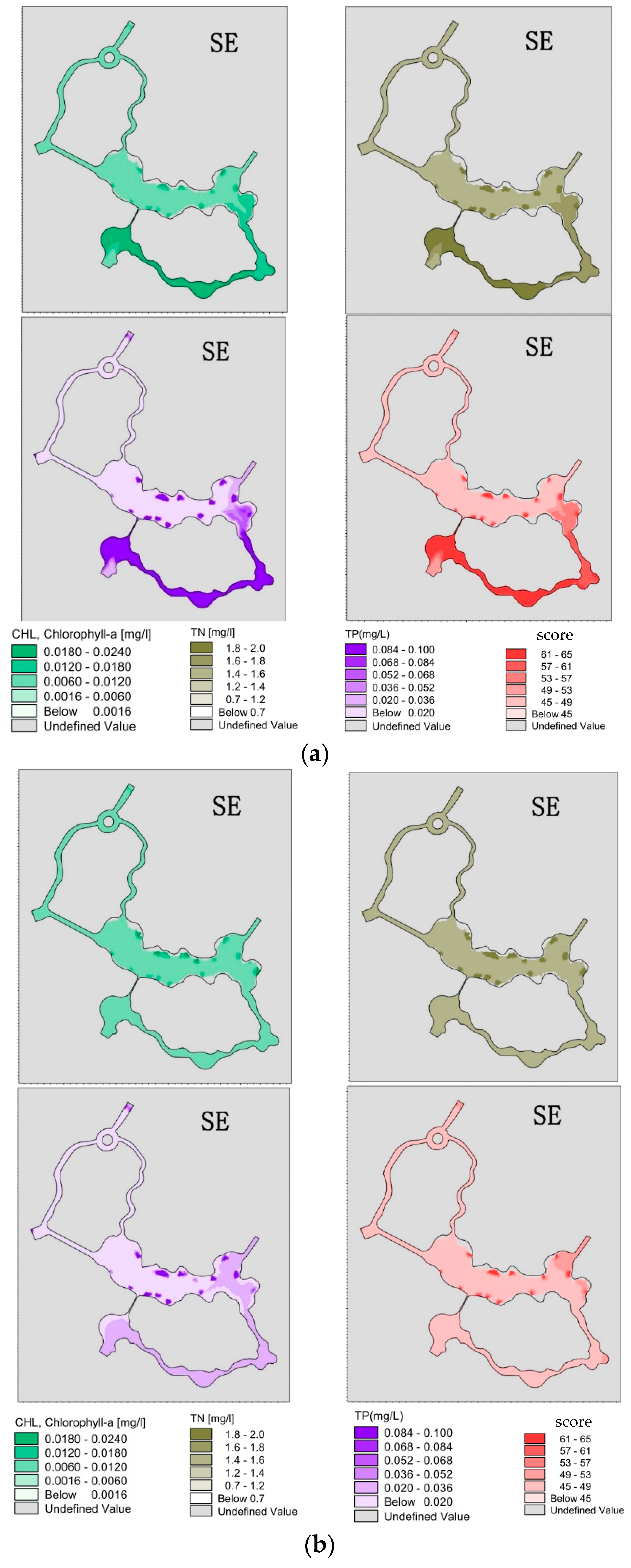
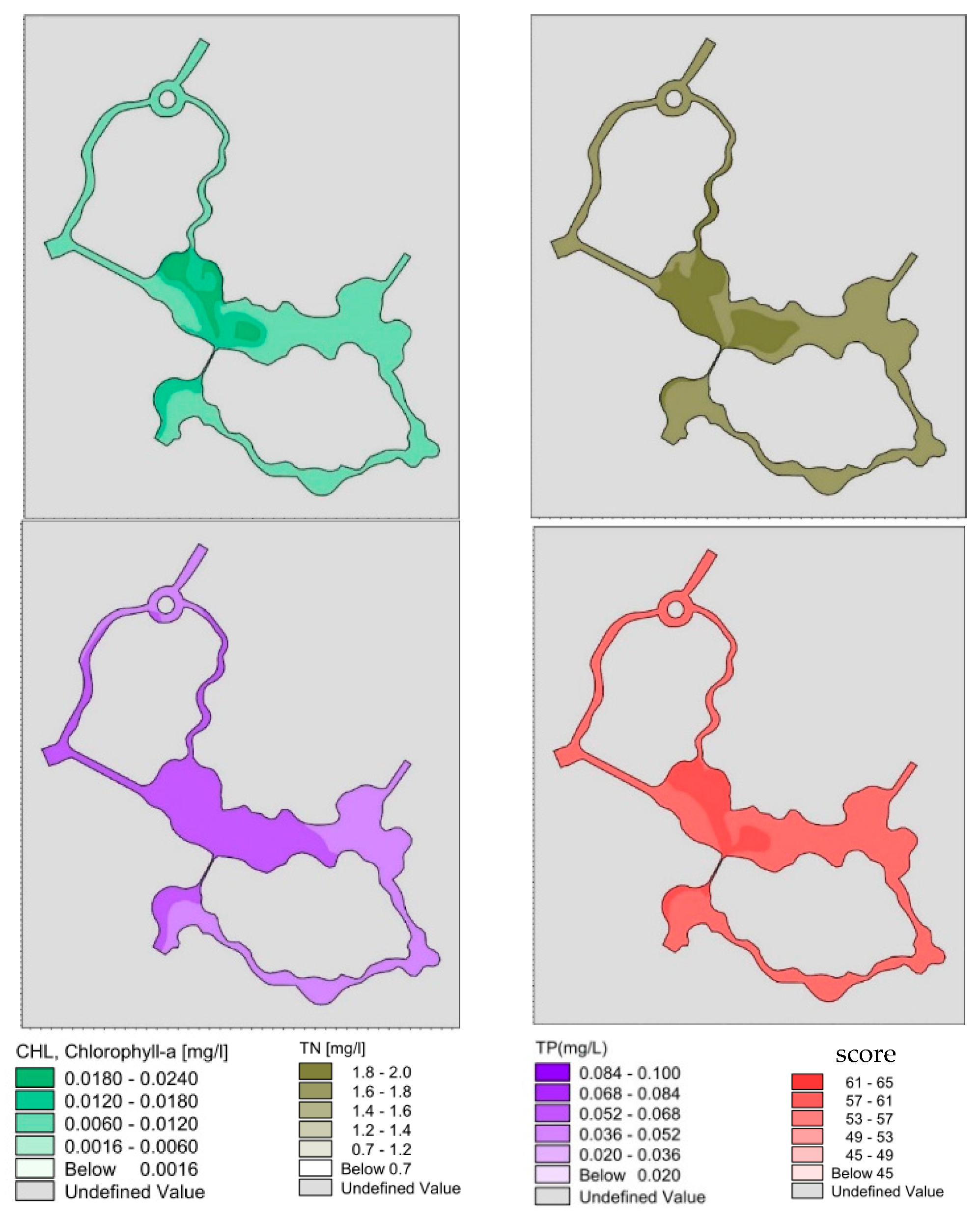
| Number | Parameters | Value [22,23,24,25] | Unit |
|---|---|---|---|
| 1 | Chl-a growth rate | 1.8 | per day |
| 2 | Chl-a sedimentation rate | 0.11 | per day |
| 3 | Sediment oxygen consumption | 0.5 | per day |
| 4 | Nitrification oxygen demand of ammonia nitrogen | 3.42 | g O2/g NH4-N |
| 5 | Denitrification oxygen demand of nitrite | 1.14 | g O2/g NO2-N |
| 6 | Denitrification rate | 0.1 | per day |
| 7 | Phosphate degradation rate | 0.06 | g P/m3/day |
| Number | Size | |
|---|---|---|
| #1 | sluice | Net width of 9 m, bottom elevation of 1.2 m |
| pump | Single pump flow rate of 1.85 m3/s with a total of two | |
| #2 sluice | Net width of 10 m, bottom elevation of 1.0 m | |
| #3 sluice | Net width of 9 m, bottom elevation of 1.5 m | |
| #4 culvert | Net size of 2 m × 2 m | |
| Time (24 h) | Pump | #1 Sluice | #2 Sluice | #3 Sluice | #4 Sluice | Remarks |
|---|---|---|---|---|---|---|
| Before pumping | Close | Open | Open | Open | Open | / |
| 0:00~22:00 | Open | Close | Open | Close | Close | Shuijie and central landscape lake area water diversion |
| 22:00~6:00+1 | Open | Close | Close | Open | Open | All areas water diversion |
| 6:00+1~7:00+1 | Close | Close | Open | Open | Open | Close #1 sluice for 1 h to prevent backwater |
| After pumping | Close | Open | Open | Open | Open | Open the flow pump |
| Program | Wind Direction | Wind Speed | Temperature | Water Diversion |
|---|---|---|---|---|
| 1 | E, SE, S | 3.4 m/s | 28 °C | No |
| 2 | SE | Pump | ||
| 3 | SE | Sluice |
| Sluice Diversion | Water Temperature Pumping | |
|---|---|---|
| Open the sluice in the diversion channel Note: Sluice diversion is generally carried out in June, July and August (temperature above 23 °C), twice per month. | 1 # pump diversion | |
| <15 °C | 15 d/time, each time 30 h | |
| 15 °C~25 °C | 10 d/time, each time 30 h | |
| >25 °C | 7 d/time, each time 30 h | |
© 2018 by the authors. Licensee MDPI, Basel, Switzerland. This article is an open access article distributed under the terms and conditions of the Creative Commons Attribution (CC BY) license (http://creativecommons.org/licenses/by/4.0/).
Share and Cite
Pang, M.; Song, W.; Zhang, P.; Shao, Y.; Li, L.; Pang, Y.; Wang, J.; Xu, Q. Research into the Eutrophication of an Artificial Playground Lake near the Yangtze River. Sustainability 2018, 10, 867. https://doi.org/10.3390/su10030867
Pang M, Song W, Zhang P, Shao Y, Li L, Pang Y, Wang J, Xu Q. Research into the Eutrophication of an Artificial Playground Lake near the Yangtze River. Sustainability. 2018; 10(3):867. https://doi.org/10.3390/su10030867
Chicago/Turabian StylePang, Min, Weiwei Song, Peng Zhang, Yongxu Shao, Lanyimin Li, Yong Pang, Jianjian Wang, and Qing Xu. 2018. "Research into the Eutrophication of an Artificial Playground Lake near the Yangtze River" Sustainability 10, no. 3: 867. https://doi.org/10.3390/su10030867
APA StylePang, M., Song, W., Zhang, P., Shao, Y., Li, L., Pang, Y., Wang, J., & Xu, Q. (2018). Research into the Eutrophication of an Artificial Playground Lake near the Yangtze River. Sustainability, 10(3), 867. https://doi.org/10.3390/su10030867





